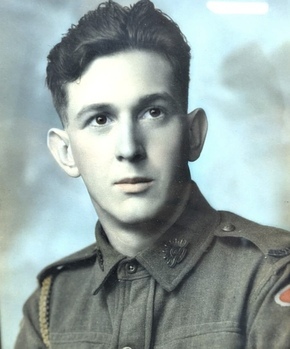
MCMILLAN, Wallace
| Service Number: | QX14588 |
|---|---|
| Enlisted: | 15 July 1940 |
| Last Rank: | Bombardier |
| Last Unit: | 2nd/10th Field Regiment |
| Born: | Brisbane, Queensland, Australia, 9 May 1919 |
| Home Town: | Brisbane, Brisbane, Queensland |
| Schooling: | Not yet discovered |
| Occupation: | Labourer |
| Died: | Illness, Thailand, 31 December 1943, aged 24 years |
| Cemetery: |
Kanchanaburi War Cemetery 1 D 19 |
| Memorials: | Australian War Memorial Roll of Honour, Ballarat Australian Ex-Prisoners of War Memorial |
World War 2 Service
| 3 Sep 1939: | Involvement Bombardier, QX14588 | |
|---|---|---|
| 15 Jul 1940: | Enlisted | |
| 15 Jul 1940: | Enlisted Australian Military Forces (WW2) , Bombardier, QX14588, 2nd/10th Field Regiment | |
| 31 Dec 1943: | Discharged |
Help us honour Wallace McMillan's service by contributing information, stories, and images so that they can be preserved for future generations.
Add my storyBiography contributed by John Baker
The McMillan family of Brisbane included four sons and a daughter. All four brothers served in the Australian Army during the Second World War. Sadly, two of them—Wallace and Hector—were captured during the fall of Singapore and later died while being held as prisoners of war by the Japanese.
Wallace McMillan was born on 9 May 1919 in Brisbane. A labourer by trade, he enlisted in the Royal Australian Artillery on 15 July 1940 and was posted shortly afterwards to the 2/10th Field Regiment. The unit embarked for Singapore on 2 February 1941, arriving on the 18th. Wallace was promoted to the rank of Bombardier in October of that year. During his service, he was hospitalised with dengue fever and later malaria.
The 2/10th Field Regiment, equipped with 25-pounder field guns, played a significant role during the Malayan campaign. On 21 January 1942, the regiment provided artillery support to Australian troops fighting along the Mersing–Endau Road. As Japanese forces pushed south along the Malay Peninsula, the regiment was involved in a series of defensive actions, including a fighting withdrawal through Johore. During this time, while supporting the 22nd Brigade, the 2/10th fired an extraordinary 900 rounds in just the first hour of one engagement.
By early February, the Australian forces had withdrawn across the Johore Causeway to Singapore Island. The 22nd and 27th Brigades took up defensive positions—22nd in the west and 27th in the north. The 2/10th was assigned to defend the sector around the causeway. At that stage, the regiment was armed with twenty-four 25-pounders and six 4.5-inch howitzers.
On 8 February 1942, the Japanese launched their assault across the Johore Strait, focusing their attack on the 22nd Brigade’s position. In anticipation, the regiment had formed an additional troop equipped with 4.5-inch howitzers and spare 18-pounders. These were used to target and sink over 30 enemy sampans attempting to cross the water. Despite the heavy resistance, the defenders were eventually overwhelmed and forced to retreat inland.
Over the following week, the 2/10th remained heavily engaged, firing thousands of shells before finally receiving the order to surrender on 15 February. During the fighting, the regiment lost six men killed, 18 wounded, and three listed as missing. A total of 834 members of the regiment were taken prisoner; 270 would not survive captivity.
Wallace McMillan was among those sent to work on the infamous Burma–Thailand Death Railway. He died of illness on 31 December 1943.









